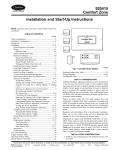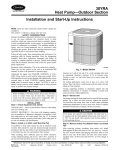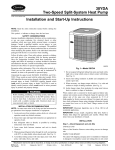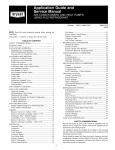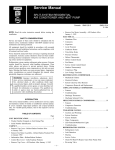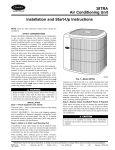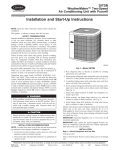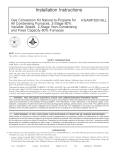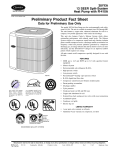Download Carrier SYNERGY 38YD Instruction manual
Transcript
38YDA Two-Speed Heat Pump Installation and Start-Up Instructions NOTE: Read the entire instruction manual before starting the installation. SAFETY CONSIDERATIONS Improper installation, adjustment, alteration, service, maintenance, or use can cause explosion, fire, electrical shock, or other conditions which may cause personal injury or property damage. Consult a qualified installer, service agency, or your distributor or branch for information or assistance. The qualified installer or agency must use factory-authorized kits or accessories when modifying this product. Refer to the individual instructions packaged with the kits or accessories when installing. Follow all safety codes. Wear safety glasses and work gloves. Use quenching cloth for brazing operations. Have fire extinguisher available. Read these instructions thoroughly and follow all warnings or cautions attached to the unit. Consult local building codes and the National Electrical Code (NEC) for special installation requirements. Recognize safety information. This is the safety-alert symbol . When you see this symbol on the unit or in instructions and manuals, be alert to the potential for personal injury. Understand the signal word DANGER, WARNING, or CAUTION. These words are used with the safety-alert symbol. DANGER identifies the most serious hazards which will result in severe personal injury or death. WARNING signifies hazards that could result in personal injury or death. CAUTION is used to identify unsafe practices which would result in minor personal injury or product and property damage. Before installing or servicing system, always turn off main power to system. There may be more than 1 disconnect switch. Turn off accessory heater power if applicable. Electrical shock can cause personal injury or death. INSTALLATION Step 1—Check Equipment and Jobsite UNPACK UNIT — Move to final location. Remove carton taking care not to damage unit. INSPECT EQUIPMENT — File claim with shipping company prior to installation if shipment is damaged or incomplete. Locate unit rating plate on unit corner panel. It contains information needed to properly install unit. Check rating plate to be sure unit matches job specifications. Step 2—Install on a Solid, Level Mounting Pad If conditions or local codes require the unit be attached to pad, tiedown bolts should be used and fastened through knockouts provided in unit base pan. Refer to unit mounting pattern in Fig. 2 to determine base pan size and knockout hole location. When installing, allow sufficient space for airflow clearance, wiring, refrigerant piping, and service. Allow 30-in. clearance to service end of unit and 48 in. above unit. For proper airflow, a 6-in. Fig. 1—Model 38YDA A92446 clearance on 1 side of unit and 12 in. on all remaining sides must be maintained. Maintain a distance of 24 in. between heat pumps. Position so water, snow, or ice from roof or eaves cannot fall directly on unit. On rooftop applications, locate unit at least 6 in. above roof surface. Where possible, place unit above a load-bearing wall. Arrange supporting members to adequately support unit and minimize transmission of vibration to building. Consult local codes governing rooftop applications. For proper unit operation and reliability, the outdoor unit must be installed with the accessory balance port, hard shut-off TXV. Do not install with evaporator coils having capillary tube metering devices. Step 3—Elevate Unit For proper drainage, the heat pump must be raised off the mounting surface. Fig. 3 shows unit with accessory heat pump feet installed. Use accessory heat pump rack in areas where prolonged subfreezing temperatures or heavy snow occur. Refer to separate Installation Instructions packaged with accessories. Step 4—Remove Indoor AccuRater® Piston NOTE: An accessory indoor thermostatic expansion valve (TXV) is required. Refer to presale literature for proper part no. After removing existing AccuRater from indoor coil, install required accessory TXV kit. (See Fig. 4 and 5.) If unit is installed Manufacturer reserves the right to discontinue, or change at any time, specifications or designs without notice and without incurring obligations. Book 1 4 PC 101 Catalog No. 563-763 Printed in U.S.A. Form 38YDA-1SI Pg 1 1-94 Replaces: 38YD-3SI Tab 5a 5a 3/8″ DIA TIEDOWN KNOCKOUTS (2) PLACES IN BASEPAN 19 15/16″ NOTES: 1. ALLOW 30″ CLEARANCE TO SERVICE SIDE OF UNIT, 48″ ABOVE UNIT, 6″ ON ONE SIDE, 12″ ON REMAINING SIDE, AND 24″ BETWEEN UNITS FOR PROPER AIRFLOW. 2. MINIMUM OUTDOOR OPERATING AMBIENT IN COOLING MODE IS 55° F AND MAX 125° F. 3. SERIES DESIGNATION IS THE 13TH POSITION OF THE UNIT MODEL NUMBER. 4. CENTER OF GRAVITY AIR IN AIR DISCHARGE 13 1/2″ AIR IN 4″ C L 9 3/4″ AIR DISCHARGE 8 3/16″ AIR IN 7/8″ FIELD POWER SUPPLY CONN 7/8″ DIA HOLE WITH 1 1/8″ DIA KNOCKOUT AND 1 3/8″ DIA KNOCKOUT DIA VAPOR LINE CONN FIELD CONTROL SUPPLY CONN 7/8″ DIA HOLE 34 15/16″ 2 1/2″ 3/8″ DIA LIQUID LINE CONN 1 9/16″ AIR DISCHARGE 30″ 39 13/16″ ACCESS PANEL 33 7/8″ 27 1/2″ 10 1/2″ 16 3/4″ 4 3/16″ 1 3/4″ 2 1 1/4″ 15/16″ A93262 Fig. 2—Unit Reference Drawing with a FK4 or FC4 fan coil, no TXV change is necessary since these fan coils are factory-equipped with proper TXV. Install TXV kit to indoor coil as follows: 1. Install suction tube adapter. 2. Install liquid flare-to-sweat adapter. 3. Install TXV on liquid flare-to-sweat adapter. 4. Connect external equalizer tube to fitting on suction tube adapter. 5. Position sensing bulb on horizontal portion of suction tube adapter. Secure using supplied hardware. Insulate bulb after installation. 6. Check all connections for leaks. DO NOT BURY MORE THAN 36 IN. OF REFRIGERANT TUBING IN GROUND. If any section of tubing is buried, there must be a 6-in. vertical rise to the valve connections on the outdoor unit. If more than the recommended length is buried, refrigerant may migrate to cooler buried section during extended periods of unit shutdown, causing refrigerant slugging and possible compressor damage at start-up. Step 5—Make Piping Connections Outdoor units may be connected to indoor sections using accessory tubing package or field-supplied refrigerant grade tubing of correct size and condition. Tubing diameters listed with these instructions are adequate for equivalent lengths up to 100 ft. Do not install equivalent interconnecting tubing lengths greater than 100 ft. Do not increase or decrease interconnecting tubing diameters. 2 In some cases noise in the living area has been traced to gas pulsations from improper installation of equipment. COIL INSTALLATION RECOMMENDATIONS SENSING BULB 1. Locate the unit away from windows. 2. Ensure that vapor and liquid tube diameters are appropriate to the capacity of the unit. (See Table 1.) EQUALIZER TUBE 3. Run refrigerant tubes as directly as possible by avoiding unnecessary turns and bends. 4. Leave some slack between the structure and the unit to absorb vibration. THERMOSTATIC EXPANSION VALVE 5. When passing refrigerant tubes through the wall, seal the opening with RTV or other pliable silicon-based caulk. (See Fig. 6.) Fig. 4—TXV Installed 6. Avoid direct lineset contact with water pipes, ductwork, floor joists, wall studs, floors, and walls. 10 O'CLOCK 2 O'CLOCK 7. Do not suspend refrigerant tubing from joists and studs with a rigid wire or strap which comes in direct contact with the tubing. (See Fig. 6.) SENSING BULB STRAP 8. Ensure that tubing insulation is pliable and completely surrounds the vapor line. 9. When necessary, use hangar straps which are 1 in. wide and conform to the shape of the tubing insulation. (See Fig. 6.) SUCTION TUBE 10. Isolate the hangar straps from the insulation by using metal sleeves bent to conform to the shape of the insulation. 8 O'CLOCK 7/8″ O.D. & SMALLER If refrigerant tubes or indoor coil is exposed to atmospheric conditions for longer than 5 minutes, it must be evacuated to 500 microns to eliminate contamination and moisture in the system. 036, 048 060 LIQUID Connect Tube Diameter Diameter 3/8 3/8 3/8 3/8 4 O'CLOCK LARGER THAN 7/8″ O.D. A81032 Fig. 5—Positioning of Sensing Bulb Outdoor unit contains correct system refrigerant charge for operation with indoor unit of the same size when connected by 15 ft of field-supplied or factory accessory tubing. Check refrigerant charge for maximum efficiency. (See Step 9—Checking Charge.) Table 1—Refrigerant Connections and Recommended Liquid and Vapor Tube Diameters (In.) UNIT SIZE A91277 VAPOR Connect Tube Diameter Diameter 7/8 7/8 7/8 1-1/8 REFRIGERANT TUBING — Connect tubing to fittings on outdoor unit vapor and liquid service valves. (See Fig. 2.) Notes: 1. Tube diameters are for lengths up to 100 equivalent ft. 2. Do not increase or decrease tubing sizes. A brazing shield MUST be used when tubing sets are being brazed to the service valves to prevent damage to the painted unit surface. Relieve all pressure before refrigerant system repair or final disposal to avoid personal injury or death. Use all service ports and open all flow-control devices, including solenoid valves. To avoid valve damage while brazing, service valves must be wrapped with a heat-sinking material such as a wet cloth. Fig. 3—Accessory Heat Pump Feet SWEAT CONNECTION — Use refrigerant grade tubing. Service valves are closed from factory and ready for brazing. After wrapping the service valve with a wet cloth, the tubing set can be brazed to the service valve using either silver bearing or non-silver bearing brazing material. Consult local code requirements. Refrigerant tubing and indoor coil are now ready for leak testing. This check should include all field and factory joints. A93567 OUTDOOR UNITS CONNECTED TO FACTORY-APPROVED INDOOR UNITS See Product Data Digest for factory-approved indoor units. 3 ROUTE GROUND AND POWER WIRES NOTE: AVOID CONTACT BETWEEN TUBING AND STRUCTURE INDOOR WALL According to NEC, ANSI/NFPA 70, and local codes, the cabinet must have uninterrupted or unbroken ground to minimize personal injury if an electrical fault should occur. The ground may consist of electrical wire or metal conduit when installed in accordance with existing electrical codes. Failure to follow this warning could result in electrical shock, fire, or death. OUTDOOR WALL CAULK Remove access panel and control box cover to gain access to unit wiring. Extend wires from disconnect through power wiring hole provided and into unit control box. (See Fig. 2.) Size wires per NEC but not smaller than minimum wire size shown in Product Data Digest. INSULATION VAPOR LINE LIQUID LINE THROUGH THE WALL CONNECT GROUND AND POWER WIRES — Connect ground wire to ground connection in control box for safety. Connect power wiring to leads provided. (See Fig. 7.) JOIST HANGER STRAP (AROUND VAPOR LINE ONLY) DISCONNECT PER N.E.C. AND/OR LOCAL CODES CONTACTOR VAPOR LINE FIELD POWER WIRING 3 PHASE ONLY BLUE FIELD GROUND INSULATION 1″ MIN WIRING LIQUID LINE SUSPENSION GROUND LUG Fig. 7—Line Power Connections A92469 A94025 CONNECT CONTROL WIRING — Route 24-v control wires through control wiring grommet and connect to leads provided in unit control box. (See Fig. 7.) Fig. 6—Piping Installation Step 6—Make Electrical Connections Use No. 18 AWG color-coded, insulated wire. If thermostat is located more than 100 ft from unit (as measured along the control voltage wires), use No. 16 AWG color-coded wire to avoid excessive voltage drop. To avoid personal injury or death, do not supply power to unit with compressor terminal box cover removed. The outdoor unit requires a minimum of 27-va, 24-vac control power. Be sure field wiring complies with local and national fire, safety, and electrical codes, and voltage to system is within limits shown on unit rating plate. Contact local power company for correction of improper voltage. See unit rating plate or Product Data Digest for recommended circuit protection device. NOTE: Operation of unit on improper line voltage constitutes abuse and could affect unit reliability. See unit rating plate. NOTE: Use copper wire only between disconnect switch and unit. NOTE: Install branch circuit disconnect per NEC of adequate size to handle unit starting current. Locate disconnect within sight from and readily accessible from unit, per Section 440-14 of NEC. AIRFLOW SELECTION FOR 58MVP FURNACE — The 58MVP provides high- and low-speed blower operation to match the heat pump/cooling heating capacities of the compressor at high and low speeds. To select the recommended airflow, refer to Table 2 and the 58MVP Installation Instructions. The 58MVP utilizes a control center that allows the installing technician to select proper airflows. For adjustments to the manual switches labeled A/C and CF and recommended switch positions, refer to Table 2. Highspeed airflow is determined by the position of the A/C switches, and low-speed airflow is determined by the position of the CF switches. This furnace has a built in, non-adjustable 90 sec off delay for high and low blower operation. AIRFLOW SELECTION FOR FK4B FAN COILS — The FK4B provides high- and low-speed blower operation to match the capacities of the compressor at high and low speeds. To select the recommended airflow, refer to Table 3 and the FK4B Installation Instructions. The FK4B utilizes an EASY SELECT control board that allows the installing technician to select proper airflows. For adjustments to the control board and recommended H/P SIZE and CFM ADJUST selections, refer to Table 3. It is recommended 4 Table 2—58MVP Airflow Selection 38YDA 036 048 060 HIGH-SPEED A/C SETUP SWITCH POSITION A/C-1 A/C-2 A/C-3 OFF OFF ON OFF ON ON OFF ON ON LOW-SPEED CF SETUP SWITCH POSITION CF-1 CF-2 CF-3 OFF ON OFF ON ON OFF ON ON OFF FURNACE MODEL/HEATING SIZE 060 High 1200 — — 080 Low 800 — — High 1200 — — 100 Low 800 — — High 1200 1600 1600* Low 800 1000 1000 * Efficiency rating obtained at 1600 CFM. If 2000 CFM is desired, adjust airflow per 58MVP Installation Instructions. Table 3—FK4B Airflow Selection 38YDA 036 048 060 FK4B 001 002 003 004 005 006 006 006 EASY SELECT CONTROL BOARD H/P SIZE CFM ADJUST Blue Wire Black Wire 036 MED 036 MED 036 MED 036 MED 036 MED 036 MED 048 MED 060 MED CFM (HP-EFF) Cool High 1250 1250 1120 1150 1200 1180 1575 1865 Heat Low 770 770 710 690 775 825 1100 1300 High 1365 1365 1220 1260 1310 1285 1710 2050 Low 835 835 770 755 835 900 1195 1435 to Fig. 8C or 8E and the humidity rises, the humidistat contacts open and de-energize the relay. If the relay is de-energized, the system will operate on high-speed compressor and high-speed airflow until the humidistat closes. HP-EFF be used for the TYPE selection to maximize efficiency. Refer to the FK4B Installation Instructions for other TYPE selections. This fan coil has an adjustable blower off delay factory set at 90 sec for high and low operation. LCC Operation For Fig. 8D Step 7—Install Electrical Accessories Due to the indoor control logic, the standard blower operation of systems is covered in Fig. 8D. The blower runs in high or low speed in conjunction with compressor high- or low-speed operation. When the LCC is wired according to Fig. 8D and the humidity rises, the humidistat contacts open and de-energize the relay. If the relay is de-energized, the system will operate on high-speed compressor and low-speed airflow until the humidistat closes. Refer to the individual instructions packaged with the kits or accessories when installing. Available electrical accessories include latent capacity control. Consult Product Data Digest for proper kit part no. and application. See Fig. 8 and Table 4 for typical accessory wiring diagrams. Table 4—Wiring Diagram Reference Low-ambient kits are not available for 2-speed units. Do not attempt to operate in cooling below 55°F or modify control system for low-ambient operation. Compressor damage may occur. OUTDOOR UNIT LATENT CAPACITY CONTROL (LCC) The purpose of an LCC is to provide a dehumidification mode, assuring a 75 percent or less system sensible heat ratio. If the indoor unit installed contains an ICM blower, such as FK4 or 58MVP, no LCC is required. The indoor products which contain ICM blowers have enough CFM range to provide proper airflow for low-speed cooling. If the indoor unit installed has a standard PSC blower motor, the low-speed airflow available will be too great to assure 75 percent or less system sensible heat ratio. The LCC for standard blower products consists of a standard humidistat which opens contacts on humidity rise and a pilot duty relay with 24-v coil. 38YDA WIRING DIAGRAM C D E F Indoor Units Covered 58EJA 58MCA FA4A 58MXA 58DFA 58TMA FK4B 58MVP FB4A 58PAV 58EFA 58TUA FC4B 58RAV 58GFA 58WAV 58ZAV A B Step 8—Start-up 1. The outdoor unit is equipped with a crankcase heater which operates at temperatures less than 75°F. If the outdoor temperature is less than 75°F, energize crankcase heater 24 hrs before starting unit. To energize heater only, set indoor thermostat at the OFF position and close the power disconnect to the unit. NOTE: If an LCC is desired, the low-speed airflow must be maintained so that a minimum of 300 CFM/ton can be supplied during high-speed LCC operation. 2. Fully back seat (open) liquid and vapor tube service valves. 3. Unit is shipped with valve stem(s) front seated and caps installed. Replace stem caps after system is opened to refrigerant flow (back seated). Replace caps finger tight and tighten additional 1/12 turn (20 ft-lb torque) with wrench. LCC Operation For Fig. 8C and 8E The standard blower operation of systems is covered in Fig. 8C and 8E. The blower runs in high speed regardless if compressor operation is high or low speed. When the LCC is wired according 4. Close electrical disconnects to energize system. 5 TWO SPEED HEAT PUMP TWO SPEED THERMOSTAT R R C C C G G W2 W2 W2 Y2 Y/Y2 Y2 E E R TRANS. TWO SPEED HEAT PUMP TWO SPEED THERMOSTAT R R R C C C G G W2 W2 Y2 W3 L L L O O O Y1 Y1 Y1 Y2 Y/Y2 E W3 W2 W/W1 L L O O Y1 Y1 B A93570 A A93106 TWO SPEED HEAT PUMP TWO SPEED THERMOSTAT R R TRANS. C TWO SPEED HEAT PUMP TWO SPEED THERMOSTAT R R C C C TRANS. R R C C G G W2 W W2 Y Y1 G G W2 W2 W2 Y1 Y1 Y Y1 E E E W3 W3 W3 L L L L L O O O O O Y2 Y2 Y2 Y2 H H C R1 D R1 A93573 Fig. 8—Typical Circuit Connections 6 A93574 R TRANS. C TWO SPEED HEAT PUMP TWO SPEED HEAT PUMP TWO SPEED THERMOSTAT R R C C G G W2 W W2 Y1 Y Y1 TWO SPEED THERMOSTAT R C O O Y2 Y2 C C G W2 W/W1 W2 W2 Y1 Y/Y2 E L R G Y1 E L R TRANS. O O L L Y2 Y2 H H F R1 R1 E A93575 A93571 R1 = Relay, SPDT, pilot duty 24-v coil (HN61KK324) or equivalent R2 = Relay, SPDT, pilot duty 24-v coil (HN61KK040) or equivalent H = Humidistat, Opens on humidity rise (HL38MG026). Use separate humidistat for humidifier control. Fig. 8—Typical Circuit Connections (Continued) 5. Set room thermostat at desired temperature. The factory accessory indoor thermostats are 2-stage, with approximately 2°F difference between stages. Be sure the set point is below indoor ambient and is low enough to energize desired speed. 6. Set room thermostat at COOL or HEAT and fan switch at FAN or AUTO, as desired. Wait for the appropriate time delay(s) and for the 2-minute minimum low-speed run time. Operate unit for 15 minutes. Check refrigerant charge. Step 9—Checking Charge Service valve gage ports are not equipped with Schrader valves. To prevent personal injury, make sure gage manifold is connected to the valve gage ports before moving valves off fully back seated position. Wear safety glasses and gloves when handling refrigerant. Adjust charge in both heating and cooling by following procedure shown on the charging tables located on unit information plate on back side of access panel. Do not vent refrigerant to atmosphere. Recover during system repair or final unit disposal. Compressor damage may occur if system is overcharged. Factory charge is shown on unit rating plate. (See Fig. 2.) NOTE: When the 2-speed unit is operating at low speed cooling, the system’s vapor (suction) pressure will be higher than a standard single-speed system or high-speed cooling operation. This normal operation is due to the reduced capacity operating with typically larger indoor and outdoor coils. SYSTEM FUNCTIONS The outdoor unit control system has special functions. The following is an overview of the 2-speed control functions. Cooling Operation This product utilizes a 2-stage cooling indoor thermostat. With a call for first stage (Y1), the outdoor fan and low-speed compressor are energized. If low speed cannot satisfy the cooling demand, high speed will be energized (Y1 and Y2) by the second stage of the indoor thermostat. The thermostat has a 2°F differential 7 3-Sec Time Delay between first and second stages. After second stage is satisfied, the unit will return to low-speed operation until first stage is satisfied or until second stage is required again. Any time the control receives a 24-v input, such as Y1 or Y2, there is a 3-sec time delay before the control function is initiated. This helps prevent nuisance trips and thermostat jiggling. Heating Operation This product utilizes a 2-stage heating indoor thermostat. The first stage of heating is heat pump operation (Y1), while auxiliary or back up heat is controlled by second stage (W2). There is a 2°F differential between first and second stage. The control board determines the speed of heat pump operation. See Table 5 for ambients at which high-speed and low-speed operations occur. When high-speed heat pump is required, the control will provide a Y2 (24-vac) signal back to the thermostat to energize high-speed indicator LED. 1-Minute Speed Change Time Delay When the compressor changes speeds from high to low or low to high, there is a 1-minute time delay before the compressor will restart. The outdoor fan motor remains running. 5-Minute Time Delay The 2-speed control logic contains a 5-minute time delay that prevents the unit from short cycling after a thermostat off cycle or power interruption. The unit can be forced to operate immediately by momentarily touching a jumper between the speed-up terminals of the control board. (See Fig. 9.) The speed-up feature will not bypass any other function or time delay. Table 5—Ambient Temperatures for High- and Low-Speed Operation AMBIENT TEMPERATURE (°F) High Speed Low Speed 30 or less 31 or greater 33 or less 34 or greater 40 or less 41 or greater LM1 LM2 DFT1 DFT2 T1 T2 1 LED Function Lights When using the factory-authorized indoor thermostats with the 2-speed outdoor units, there are 2 locations where system function LED indicator lights are available. The indoor thermostat provides indicator lights for high- and low-speed operation, system malfunction, and auxiliary heat. The 2-speed control board has a LED which provides signals for several system operations. See Table 6 which provides LED functions, indicator locations, and definitions. Table 6 also provides the order of signal importance if more than 1 signal should occur. The signal to the indoor thermostat is supplied by the low-voltage L lead. S2 S1 PW2 PW1 P1 18 K7 FURN INT OFF ON 50 35 40 45 105 OFF 90 100 20 30 15 25 10 95 30 SPEED-UP 90 85 036 048 060 ZONE UNIT SIZE STAGE 2 DEFROST BALANCE LATCH TIME POINT NOTE: A signal (code) will not be sent through the L lead to the thermostat unless unit failure has occurred. (See Table 6.) Fig. 9—Two-Speed Control Board Table 6—Function Light Code and Display Location A93568 2-Minute Low-Speed Minimum CODE T’STAT UNIT DEFINITION * Constant flash No pause — X No demand Stand by 9 1 flash w/pause — X Low-speed operation 8 2 flashes w/pause — X High-speed operation 7 3 flashes w/pause X X Outdoor thermistor failure 6 The 2-speed control will energize the crankcase heater during the unit’s off cycle when the outdoor ambient is below 75°F. 4 flashes w/pause X X Coil thermistor failure 5 Outdoor Fan Motor Operation 3 flashes pause 4 flashes X X Thermistor out of range** 4 5 flashes w/pause X‡ X Pressure switch trip (LM1/LM2) 3 6 flashes w/pause† X X Compressor PTC’s out of limit 2 Constant light No pause No flash X X Board failure If the unit has not operated within the past 30 minutes, the unit will operate for a minimum of 2 minutes in low speed upon the next thermostat high or low demand. Crankcase Heater Operation The 2-speed control will energize the outdoor fan any time the compressor is operating. The outdoor fan will remain energized during the 1-minute speed change time delay and if a pressure switch or positive temperature coefficient (PTC) overload should trip. After termination of a defrost cycle, the outdoor fan will delay coming on for 20 sec. This allows the refrigerant system to recover the outdoor coil heat and minimize the "steam cloud" effect. 1 * Function light signal order of importance in case of multiple signal request; 1 is most important. † Signal at thermostat will occur after 3 consecutive attempted restarts and lockout has occurred. ‡ Will be energized if pressure switch remains open for 1 hr. ** Check both thermistors to determine which is faulty. The unit is equipped with an integrated control motor (ICM) which varies its speed by receiving a pulse width modulated (PWM) signal. The control provides the ICM with a PWM signal based on high- or low-speed unit operation and outdoor ambient. Factory Defaults The outdoor ICM motor runs at high speed whenever the compressor runs at high speed. When the compressor operates at low speed and the outdoor ambient is less than 87°F, the ICM reduces speed to conserve energy. Factory defaults have been provided in the event of failure of the ambient thermistor, outdoor coil thermistor, and/or furnace interface jumper. Refer to Table 7 for default and function. 8 Table 7—Factory Defaults FAILED COMPONENT FUNCTION Crankcase Heater Outdoor ICM Speed Second-Stage Latching DEFAULT Energized during any off cycle Run motor at maximum speed Does not function Balance point does not function, but interface still energizes furnace and locks out heat pump with a call for W2 Unit only runs in high compressor speed Defrost is initiated based on coil temperature only Anytime there is a call for W2, W3 is also energized Defrost occurs at each time interval, but terminates after 5 minutes Does not function Furnace Interface Ambient Thermistor Heating Switchover Speed Point Defrost Initiation Outdoor Thermostat for Auxiliary Heat Outdoor Coil Thermistor Defrost Initiation and Termination Furnace Interface Jumper Furnace Interface Second-Stage Latching HIGH VOLTAGE During normal operation, the compressor operates at low speed to satisfy first stage of the indoor thermostat. If the indoor thermostat temperature increases 2 degrees, the compressor shifts into highspeed operation. When the indoor thermostat temperature is satisfied, the compressor returns to low-speed, first-stage operation. L2 HI CCH ODF LM1 LM2 O DFT1 DFT2 T1 K2 K3 K4 K5 T2 S2 S1 PW2 PW1 C 1 K1 K6 P1 18 K7 FURN INT OFF ON SPEED-UP The installing technician can select high-speed compressor operation until the first stage of the indoor thermostat is satisfied. This eliminates the temperature droop of the indoor thermostat between first- and second-stage operation and holds the room temperature closer to set point when load requirements are high. To select this option, rotate the STAGE 2 LATCH potentiometer (pot) to the desired temperature. (See Fig. 11.) The pot is factory set at OFF, however, a temperature of 85°, 90°, 95°, 100°, or 105°F can be selected. The selected temperature is the outdoor temperature at which the structure’s cooling load will require high-speed operation. STAGE 2 DEFROST BALANCE LATCH TIME POINT LED 1 A93569 Fig. 11—LED And Potentiometer Location cooling load must be taken from the structure’s heat gain/loss calculations. The selected temperature is the point at which high-speed capacity is needed and is just above the low-speed balance point. (See Fig. 10.) After the temperature is selected, the unit will operate in high speed during first-stage demand at any temperature at or above the setting. 70 Zoning Selection 60 HIGH SPEE HIGH SPEED BALANCE POINT D CA 50 BTU (1000'S) LO LOW VOLTAGE If the STAGE 2 LATCH pot is set to ZONE position, the compressor operating speed in either heat or cool mode is determined by the Y1 and/or Y2 inputs. The system operates in low speed with a Y1 input and high speed with a Y2, or Y1 and Y2 input. This allows the multistage zoning system to determine what heating speed is needed regardless of outdoor temperature or switchover point. PACIT Y 40 LOW S PEED 30 CAPA STRUCTURE BALANCE POINT CITY Defrost Time Selection 20 The defrost interval can be field selected, dependent on local or geographical requirements. It is factory set at 90 minutes and can be changed to either 30 or 50 minutes by rotating the defrost time pot. (See Fig. 9.) LOW SPEED BALANCE POINT 10 50 60 70 80 90 100 110 Defrost 120 The 2-speed control logic for the defrost function is the standard time and temperature initiated, time or temperature terminated. Defrost only occurs at outdoor temperatures less than 50°F. The control initiates defrost when the outdoor coil thermistor is 30°F (± 2°) or less, and the selected defrost time (interval) has been accumulated during unit operation. Termination occurs when the coil thermistor reaches 80°F (± 5°) or the defrost period reaches a maximum of 10 minutes. TEMPERATURE (°F) A91282 Fig. 10—Typical Cooling Balance Points The unit’s capacities should be plotted versus the cooling load (heat gain) of the structure to accurately determine the STAGE 2 LATCH temperature to be selected . The unit’s capacities versus the outdoor temperature can be found in the presale literature. The 9 indoor thermostat to W3 of the control, and W2 of the control to W2 of the indoor unit. When the outdoor ambient is less than the setting of the balance point pot, the 24-vac signal will energize the auxiliary heat (W2) of the indoor unit. Defrost will always be done in high speed, regardless if unit operation requires low speed unless zoning is selected. During defrost, the unit operates in high speed, energizes the reversing valve O and auxiliary heat W2, and de-energizes the outdoor fan. Upon termination, there is be a 20-sec delay in the outdoor fan being energized. Emergency Heat If the 2-speed control receives a call for auxiliary heat (W2) without a heat pump heating (Y1) call, the second auxiliary stage (W3) will be energized. This ensures all available heat is energized if the indoor thermostat is switched to emergency heat. Field-Initiated Forced Defrost By placing a jumper across the speed-up terminals for a minimum of 5 sec and then removing it, the unit will initiate a defrost cycle. (See Fig. 9.) The cycle will occur only if the outdoor ambient is less than 50°F, regardless of outdoor coil temperature. The cycle will terminate when the coil thermistor reaches 80°F (± 5° ) or the defrost period reaches a maximum of 10 minutes. Compressor PTC Overload Protection The control senses the resistance of the compressor internal PTC overloads. If the resistance of the PTC’s is out of range, the control will shut off the unit until the resistance range is acceptable. See Table 8 for compressor PTC ranges. Furnace Interface This feature provides a heat pump lockout upon a demand for auxiliary heat W2 and must be used when interfacing a heat pump with a gas/oil furnace. Field selection of the furnace interface, FURN IN, option is done by connecting the factory-supplied jumper to the ON position of the 3 terminal connector. (See Fig. 9.) Table 8—Compressor PTC Ranges COMPRESSOR INTERNAL PTC RESISTANCE Safe Range (77°F) 1.5k to 7.8k ohms To trip 26k to 34k ohms To reset 8.4k to 10k ohms When the option is selected, the heat pump is locked out of operation any time there is a thermostat call for W2, or the outdoor ambient is below the balance point pot setting. (See Fig. 9.) When the unit requires defrost, auxiliary heat W2 energizes the furnace. After defrost is terminated, the heat pump shuts down and the furnace satisfies the thermostat. To utilize this function, the economic and/or thermal balance point must be determined. See the appropriate heat pump balance point worksheet available from your local distributor or branch. When the control turns off the outdoor unit due to out of range PTC’s, the unit will remain off for 15 minutes with the outdoor fan running. After 15 minutes the control will check the resistance every 5 minutes until it reaches the reset range. During this time, a malfunction signal will appear on the control board. If a PTC trip occurs 3 times without 12 minutes of normal operation, the control will lock out the outdoor unit operation and provide a malfunction signal at the control and indoor thermostat. Balance Point Pressure Switch Protection This feature can be used in 2 different options: furnace interface or electric heat staging. Refer to the Furnace Interface section for its application. If the heat pump is installed with a fan coil with multistages of electric heat, this option can be used to stage the banks of heat by outdoor ambient. This eliminates the need for accessory outdoor thermostats. The outdoor unit is equipped with high- and low-pressure switches, wired in series. If a control senses an opening of a pressure switch, the control will provide a 5-minute time delay in outdoor unit operation with the outdoor fan running. A malfunction signal will appear on the control when a pressure switch opens. If the switch remains open for 1 hr or longer, a malfunction signal will be provided at L terminal of the indoor thermostat. When using this option to stage electric heat, the first stage will be energized by a W2 demand, and second stage will be energized by a W3 demand. Select the W3 desired temperature by rotating the balance point pot. (See Fig. 9 or 11.) Temperatures that may be selected are 10°, 15°, 20°, 25°, 30°, 35°, 40°, and 45°F. The pot is factory set at 45°F. MAJOR COMPONENTS 2-Speed Control The 2-speed control board controls the following functions: - High- and low-compressor contactor operation - Outdoor fan motor operation - Crankcase heater operation - Compressor protection - Pressure switch monitoring - Second-stage latching - Time delays - Time/temperature defrost - Defrost interval selection - Zoning - Furnace interface - Electric heat staging Low-Speed Heating With Auxiliary Heat If the system is operating in low-speed heating and there is a demand for auxiliary heat (W2), the system will change to high-speed operation. W2 will be energized, unless the lowvoltage control wiring is configured as described in Fig. 12. TWO SPEED THERMOSTAT FAN COIL TWO SPEED HEAT PUMP W2 W2 W2 CONTROL LOGIC W3 W3 Refer to the System Functions section for individual function information. Header Pin Housing A93572 Fig. 12—Low-Voltage Control Wiring The header pin housing is the plastic assembly which holds the stripped lead ends for field connections. The 2-speed control receives the 24-vac low-voltage control system inputs through the housing and pins. The housing also contains jumpers which the control uses for system configuration, such as heat pump versus air conditioning. Refer to Fig. 13 for header pin housing configuration. Auxiliary Heat (W2) Lockout In some areas, it is necessary to disable the auxiliary heat, except for defrost, until the outdoor ambient is less than the structure’s balance point. This is accomplished by using the wiring lowvoltage as shown in Fig. 12. Wire the 24-vac W2 signal from the 10 1 C - TRANSFORMER COMMON 2 R - TRANSFORMER LINE The 2-speed control provides the electrical interlock. The contactors are supplied with 240-v coils, which reduces the va requirements of the low-voltage (24-vac) control system. 3 Temperature Thermistors 4 5 W2 - FIRST STAGE AUXILIARY HEAT 6 O - REVERSING VALVE 7 Y2 - SECOND STAGE COOLING/HEAT PUMP 8 Y1 - FIRST STAGE COOLING/HEAT PUMP 9 W3 - SECOND STAGE AUXILIARY HEAT 10 L - MALFUNCTION LIGHT Thermistors are electronic devices which sense temperature. As the temperature increases, the resistance decreases. A thermistor is used to sense outdoor ambient and coil temperature. Refer to Fig. 14 for resistance values versus temperature. 11 12 4 - TON 13 14 5 - TON THERMISTOR CURVE IF NO JUMPER IS INSTALLED, DEFAULT IS 3 - TON 90 80 RESISTANCE (KOHMS) 15 16 17 18 JUMPER FOR HEAT PUMP ONLY A93576 Fig. 13—Header Pin Housing Configuration 2-Speed Compressor 4 TON 0.70 2.20 1.00 2.20 50 40 30 20 0 0 20 40 60 80 TEMPERATURE (DEG. F) 100 120 A91431 Table 9—Two-Speed Compressor (Winding Resistance at 70°F ± 20°) 3 TON 0.80 3.20 1.30 3.10 60 10 The 2-speed compressor contains motor windings that provide low-speed 4-pole (1750 rpm) and high-speed 2-pole (3500 rpm) operation. Refer to Table 9 for appropriate winding resistances. Refer to unit wiring label for winding configuration. WINDING T1-T2 T1-T3 T1-T7 T1-T8 70 Fig. 14—Resistance Values Versus Temperature 5 TON 0.60 1.80 1.00 2.00 ICM Outdoor Fan Motor The outdoor integrated control motor (ICM) is a variable-speed motor which can operate from 400 to 900 rpm. The motor is a DC permanent magnet-type motor with the electronic controls integrated into its rear cover. The speed at which the motor operates and thus commutated is determined by a PWM signal which is received from the control board. The 2-speed compressor is protected by an internal pressure relief (IPR) which will relieve discharge gas into the compressor shell when the differential between suction and discharge pressures exceed 500 psi. EMI Filter The compressor is also protected by 3 PTC devices attached to the motor windings. The PTC’s resistance is sensed by the 2-speed control. See Table 8 for PTC resistance ranges. An electromagnetic interference (EMI) filter is installed on the high-voltage input to the ICM to prevent electromagnetic signals generated by the ICM from interfering with other home appliances such as radios or televisions. Mechanically Interlocked Contactors CARE AND MAINTENANCE Do not bypass interlocks of contactors as compressor damage will occur. For continuing high performance and to minimize possible equipment failure, it is essential that periodic maintenance be performed on this equipment. Consult your servicing contractor or User’s Manual for the proper frequency of maintenance. Frequency of maintenance may vary depending upon geographic areas, such as coastal applications. Interlocked contactors coils are 240v, high voltage. Electrical shock can cause personal injury or death. Step 1—Leave User’s Manual With Homeowner The 2-speed products are equipped with mechanically interlocked contactors. Each contactor has interconnecting linkage, providing independent interlocks. Explain system operation and maintenance procedures outlined in User’s Manual. 11 Copyright 1993 CARRIER Corp. • 7310 W. Morris St. • Indianapolis, IN 46231 13131 Manufacturer reserves the right to discontinue, or change at any time, specifications or designs without notice and without incurring obligations. Book 1 4 PC 101 Catalog No. 563-763 Printed in U.S.A. Form 38YDA-1SI Pg 12 1-94 Replaces: 38YD-3SI Tab 5a 5a












